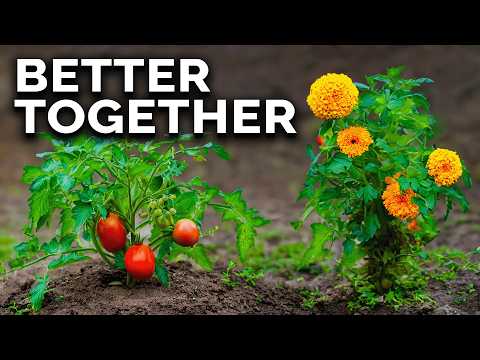There are many reasons to get rid of your lawn and say goodbye to grass. Perhaps grass just doesn’t grow well in your yard, and you have a lawn full of unsightly weeds.
Maybe you are ready for a change and want to do something more interesting with your yard than the typical sea of green. You might be looking for a more environmentally friendly alternative to grass, or maybe your lawn is simply too much work.
Trying to maintain a perfect, uniformly green, weed-free grass lawn is expensive, time-consuming, and frustrating. It often relies on repeated applications of chemical fertilizers and herbicides. Plus, it doesn’t do anything to benefit pollinators, birds, or other wildlife.
Many benefits come with removing your grass:
- Less water consumption
- Less chemical runoff from fertilizers and herbicides
- No more mowing
- More space for beautiful flowers, shrubs, and trees
- Space to grow your own food
- Attract pollinators and birds
- Save money and time on lawn care and maintenance
What to Ask Yourself
 Consider your desired outcome before taking action to remove your grass.
Consider your desired outcome before taking action to remove your grass.
Before you begin killing off your grass, think about your intended outcome. Ask yourself these questions: How much time do you have for this project? What is your budget? What would you like to grow instead of grass? And if you live in a neighborhood with a homeowners association, will the HOA allow you to replace your grass with something else?
Once the grass is gone, you can create an even better landscape with your yard. If you are ready to turn your turf grass lawn into something beautiful, useful, and beneficial, read on to find out how to get rid of your lawn and convert it into something else!
How to Kill Grass
The first step in removing your lawn, of course, is removing the grass. You’ll need to decide how much grass you want to eliminate – the whole thing or just a section of your lawn. The decision is up to you, your goals, timeframe, and budget. There are several methods you can use to get rid of your grass.
Physically Remove the Grass
Remember to shake off loose soil when extracting grass clumps to avoid removing the entire topsoil layer.
One of the quickest ways to get rid of your grass, at least in small patches, is to remove it physically. You’ll have to dig out the roots, but most grasses have shallow root systems.
As you dig out clumps of grass, shake out the loose soil so you aren’t removing the entire layer of topsoil along with the grass. If you are working with a larger area, try renting a sod cutter to make the task more efficient.
Before you start digging up your yard, locate your utilities. You don’t want to accidentally dig into any underground lines, pipes, or cables. Also, make note of any buried sprinkler systems. You can compost clumps of grass that you remove, but give it plenty of time to decompose so the roots and seeds won’t grow back.
Pros
- No chemical usage
- Free (unless you rent a sod cutter)
- Physically removes grass and weeds
- Immediate results
Cons
- Labor intensive
- Some grass may be difficult to dig out
- Bare soil encourages weed growth
Tilling
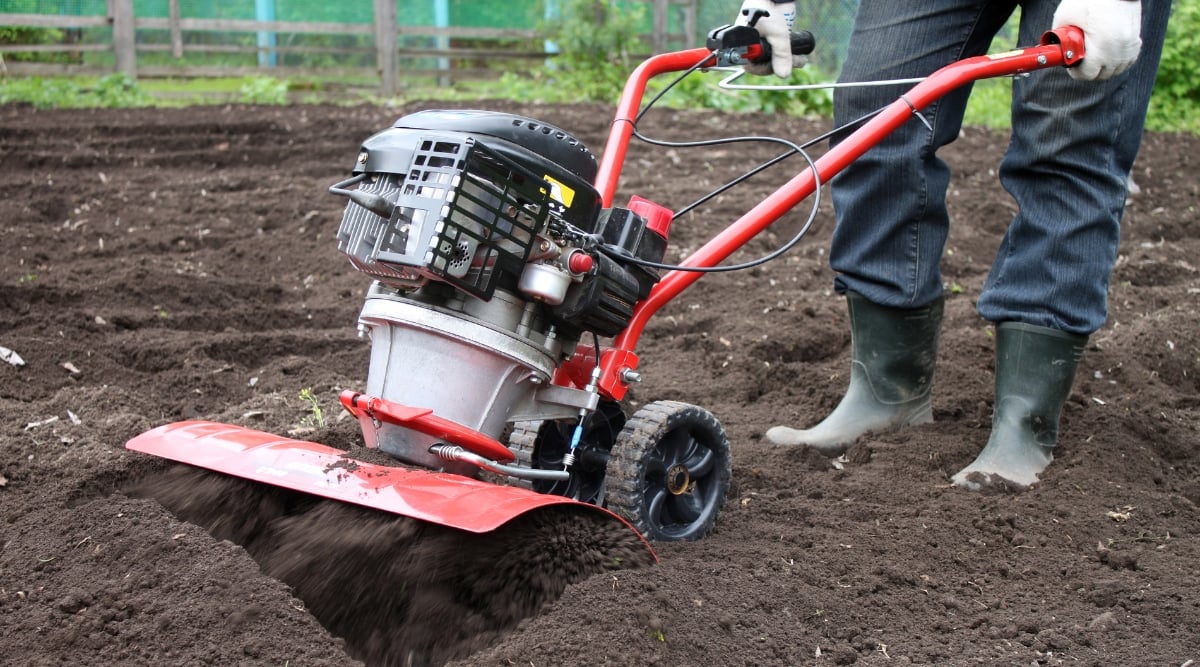 To enhance efficiency, consider a combination of tilling and using black plastic.
To enhance efficiency, consider a combination of tilling and using black plastic.
Tilling is a great way to remove the grass in your yard and start over, especially if you already have access to a tiller. You will, however, need to till repeatedly to continue disturbing and killing the grass and weeds over a period of time.
Each time you till, you churn the soil and disturb the root systems. After a while, the plants and roots will eventually die, but this will take time. Note that some types of grass, like Bermuda grass, can sprout and regrow from small pieces, so this method does not work for every grass type!
Your progress will also be affected by rain and wet soil conditions. A combination of tilling and black plastic is often more efficient. Till first, then cover the area with plastic sheeting. Before you till, however, ensure you know where all your utility lines are and any underground sprinkler system components.
Pros
- Inexpensive (unless you need to rent a tiller)
- No chemical usage
Cons
- Time-consuming
- Labor intensive
- Needs to be repeated several times
- Can damage tree roots and buried utilities
Black Plastic
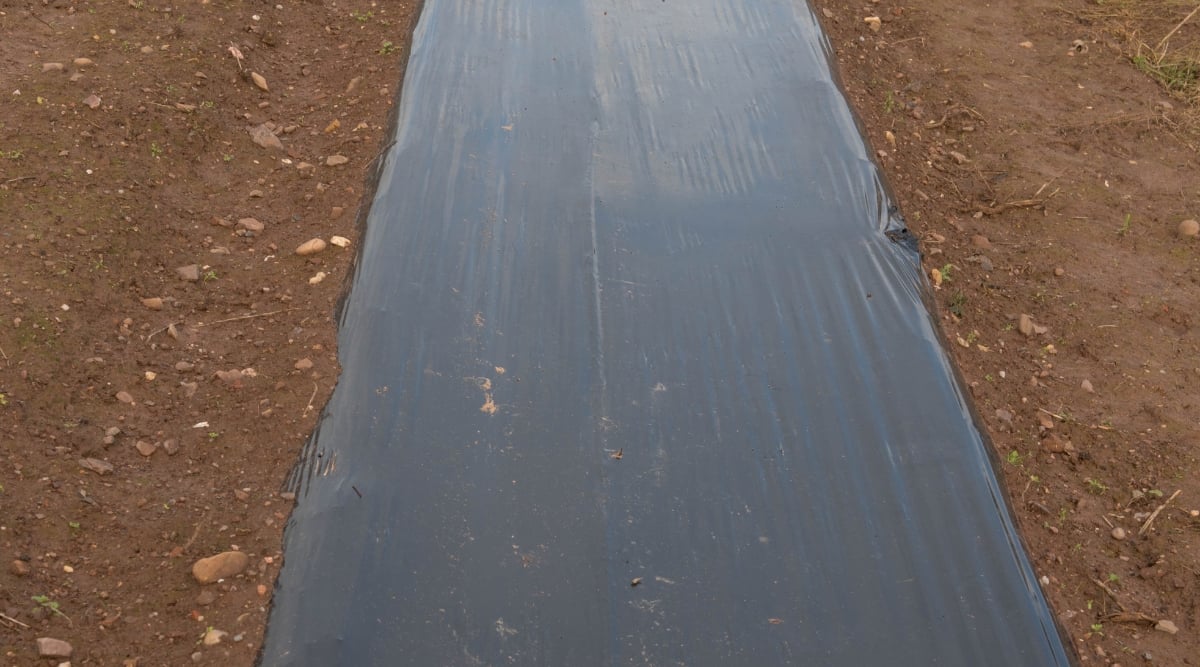 Roll out sizable black plastic sheets to cover the specific areas of your lawn you wish to eliminate.
Roll out sizable black plastic sheets to cover the specific areas of your lawn you wish to eliminate.
Heavy-duty black plastic blocks sunlight and water from reaching plants and soil below. You can buy large sheets of black plastic and roll them out to completely cover the parts of your lawn you want to kill. You’ll need to secure the plastic with rocks, bricks, or other heavy objects to keep it from blowing away.
You’ll need a lot of patience with this project. The plastic needs to be in place for at least 2 or 3 months to kill the grass effectively. Plastic sheeting works best in the summer when it’s hot, so the combination of heat and lack of resources most effectively kills the grass beneath. In the fall, you may still want to till or dig to loosen the soil and make room for new plantings.
Alternatively, lay a thick layer of cardboard over your grass in the fall. Cover it with topsoil and mulch. In spring, you can plant directly into it! Be ready to pull up any grass that sneaks through your barrier.
Pros
- No chemical usage
- Encourages break-down of dead vegetation
Cons
- Have to buy plastic
- Very time-consuming
- Grass may still re-sprout even after it appears dead
- Visually unappealing to have a black plastic lawn during the summer
Weed and Grass Killers
 Ensure strict adherence to the product’s label instructions and wear the appropriate protective gear.
Ensure strict adherence to the product’s label instructions and wear the appropriate protective gear.
Lawn chemicals are harmful to the environment, animals, and insects, and also potentially harmful to humans. If you go this route, carefully follow the directions on the product label and wear appropriate protective gear.
Weed and grass killers will kill all the vegetation growing in your lawn and cause it all to turn brown. It will not, however, kill the ungerminated weed seeds in the soil. Chemicals typically require more than one application to kill off a lawn full of grass or weeds completely, and it will take about two weeks for each application to reach its full effect.
Pros
- Efficient
- Simple
- Faster than black plastic
Cons
- Expensive
- Potential health concerns
- Herbicide runoff and spray in the environment
- Need to reapply multiple times
No More Grass – Now What?
With the grass out of the way, you now have a blank slate. You may already have a plan or still be working out your next landscape design. Before you jump right into your next project, however, there are some things you can do to help prepare your plot.
Do a Soil Test
 Contact your local cooperative extension office to learn more about soil testing.
Contact your local cooperative extension office to learn more about soil testing.
Testing your soil will give you a much greater knowledge about your soil. You will learn about your soil type, what nutrients your soil has, and what it may lack.
You will also learn your soil pH level, how well the soil holds water, and other useful information. Contact your local cooperative extension office to help you get started with soil testing.
Amend the Soil as Needed
 Depending on the garden you aim to cultivate, you can tailor your soil to suit your desired plants.
Depending on the garden you aim to cultivate, you can tailor your soil to suit your desired plants.
If you have a large plot of bare ground, you have a perfect opportunity to enrich your soil, creating the perfect environment to start a fresh garden. Depending on the type of garden you want to grow, you can completely customize your soil to match the plants you want.
Will you need loose, well-drained soil, or will you need to add some compost before you get started? Now is the ideal time to amend your soil to customize it to your landscape plan.
Smooth and Level the Soil
 Reworking the topsoil layer is one advantage of having bare ground.
Reworking the topsoil layer is one advantage of having bare ground.
Another benefit of having bare ground is that you can rework the topsoil layer. If you have tilled or physically removed the grass, you will have completely bare ground to work with.
Now is the ideal opportunity to level your soil, smooth out any odd lumps and bumps, and even change the contours slightly to improve drainage or help prevent water loss. As you design your new landscape, you can customize your soil based on your planned layout.
Keep Pulling Weeds
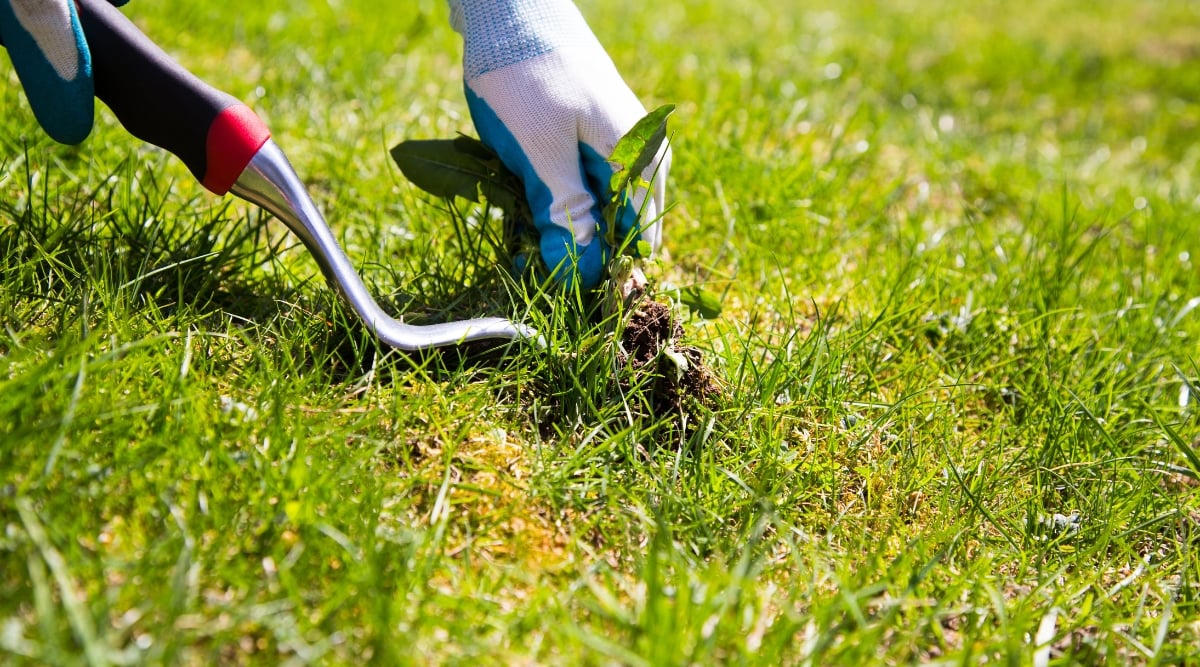 Throughout any gardening project, vigilance against bothersome weeds is essential.
Throughout any gardening project, vigilance against bothersome weeds is essential.
As soon as you create bare ground, weeds will start to encroach. Get out there every day or two and keep pulling weeds as they appear. It’s always easier to stay ahead of weeds than to allow them to reach maturity and spread more seeds.
You can keep the bare ground covered with black plastic sheets or even layers of cardboard to help prevent weeds before you start your new landscape plantings. Once the new plantings are in place, add a layer of mulch around your plants to inhibit weed growth. At any phase of any gardening project, you will need to continue to keep an eye on those pesky weeds.
What to Grow Instead of Grass
So you’ve given up the lawn mower, the string trimmer, the lawn aerator, the sprinkler, herbicides, and fertilizers. What can you do with all that space that used to be just grass?
From a single raised bed to an entire landscape makeover, you can replace your lawn with any type of interesting landscaping. The following ideas can help get you started.
Raised Beds
 Creating a raised bed garden is a great idea to maximize your yard’s potential.
Creating a raised bed garden is a great idea to maximize your yard’s potential.
Creating a raised bed garden is an excellent way to use your yard. The fabulous thing about raised beds is that you can use them without removing your lawn completely. If you have a smaller space, you can replace parts of your lawn with raised beds and use mulch to fill in the spaces between the beds.
Raised beds are extremely versatile. You can use one bed or multiple beds for different groupings of plants. Grow a vegetable garden, herb garden, butterfly garden, and much more in raised beds.
They work well for both annuals and perennials so that you can get creative. Raised beds will, however, typically require some supplemental watering, but you can target your watering to a very limited space and, therefore, not waste water.
Cultivate an Edible Landscape
 You can cultivate a delightful edible landscape regardless of your climate zone.
You can cultivate a delightful edible landscape regardless of your climate zone.
Anyone can create an edible landscape; you don’t need to eat everything you plant. Some edible plants are very ornamental and provide a beautiful garden that is also a food source. If you have enough sun to grow grass, you also have enough sun to grow edible plants.
An edible landscape can include a traditional vegetable garden with seasonal fruits and vegetables like strawberries, tomatoes, squash, peppers, or corn. There are also edible flowers that are beautiful and fun to grow, such as borage and nasturtiums. And certainly don’t forget about fruiting shrubs and trees such as blueberries, plums, figs, and apples. No matter which climate zone you live in, you can grow edible goodies in your own yard.
Grow a Pocket Prairie
 Native prairie plants are generally low-maintenance and thrive when planted together.
Native prairie plants are generally low-maintenance and thrive when planted together.
Would you like to create a beautiful bit of natural grassland that is rich in biodiversity and supports a plethora of pollinators? Convert any part of your sunny landscape to a pocket prairie. A pocket prairie is simply a small patch of native prairie plants.
These plants are typically very easy to grow. When grown together in your landscape, they create a miniature grassland habitat with native grasses and flowering plants to enrich the ecosystem.
One of the keys to establishing a healthy pocket prairie is diversity. Try a combination of shorter and taller plants and a mix of grasses and forbs. There are a huge number of native sun-loving plants you can use for this project.
If you need some ideas, you can use the following plants to get you started with a nice assortment:
Blue Grama Grass – A mid-sized native grass that attracts birds and butterflies.
Pink Muhly Grass – A mid-sized native grass with spectacular pink fall flowers.
Purple Coneflower – A tall native wildflower with showy flowers that are very attractive to pollinators and birds.
Common Blue Violet – You may think of this plant as a weed in your lawn, but it makes a great ground cover in your pocket prairie!
Wild Bergamot – A native mint with showy purple flowers for hummingbirds and butterflies.
Plant an Herb Garden
 The size of your herb garden can vary depending on the number of herbs you wish to cultivate.
The size of your herb garden can vary depending on the number of herbs you wish to cultivate.
After you get rid of your lawn, you have more room for useful plants! Like the edible landscape, an herb garden is a great way to use your land to grow useful plants. Even if you never cook with herbs, they make very attractive landscaping plants.
You can easily incorporate herbs into a perennial, kitchen, or vegetable garden or establish a separate space just for herbs. Herb gardens can be large or small, depending on how many herbs you want to grow.
Combine perennial herbs with annuals such as basil or perennials like lavender or sage. Fennell and dill attract pollinators while blooming and are caterpillar host plants for the black swallowtail butterfly. Some herbs, like rosemary, are small shrubs and add interesting diversity and structure. Herbs are amazingly useful, not just for spicing up your cooking but also for their natural beauty!
Rock Garden or Xeriscape
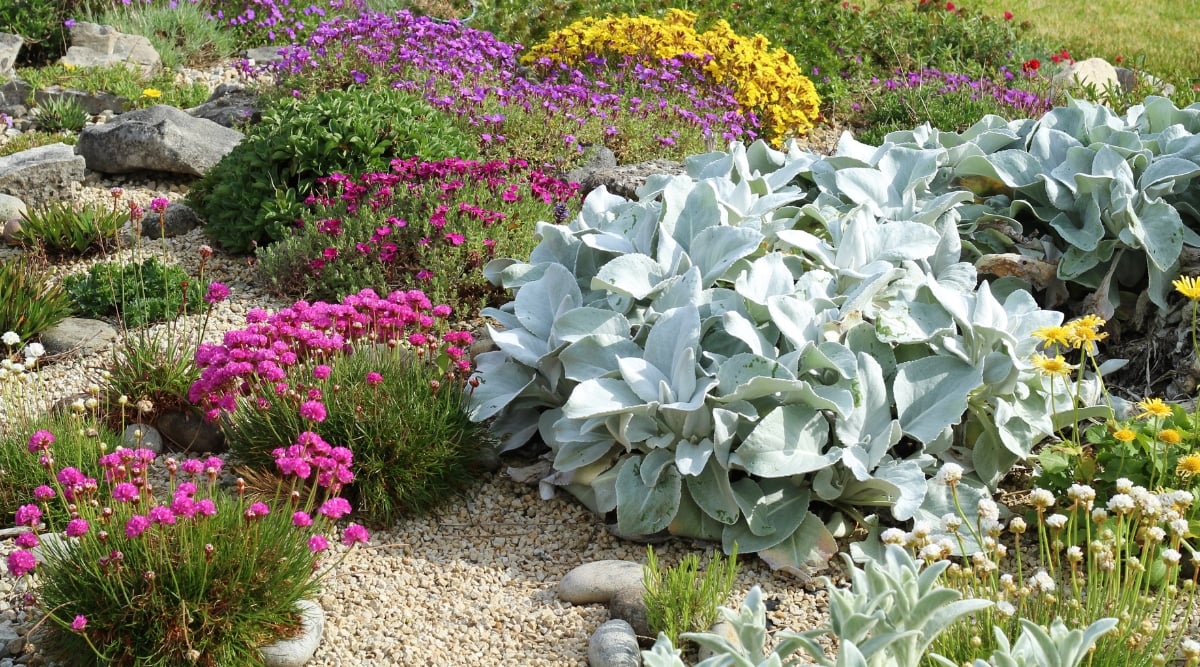 Planning a xeriscape is an easy way to reduce water usage.
Planning a xeriscape is an easy way to reduce water usage.
Do you need to constantly water your lawn to keep it green? Rather than using so much water to keep your grass alive, grow naturally drought-tolerant plants. Getting rid of your lawn can conserve a lot of water.
Planting a xeriscape doesn’t take any special tools or equipment. It simply means growing an assortment of drought-tolerant plants that thrive in well-drained soil without supplemental watering or with limited supplemental watering.
When people think of rock gardens, they often imagine a garden full of cacti and succulents. You can, of course, create a rock garden with succulents if you live in the right climate. If you don’t live in the desert, don’t worry; plenty of xeriscape-friendly plants might work for you.
Here are a few examples of drought-tolerant plants that aren’t cacti or succulents:
Sea Holly – This fun plant has purplish-green prickly-looking flowers that pollinators love. It thrives in dry soil and can be grown as a perennial in USDA zones 5-9.
Adam’s Needle – This hardy yucca has spectacular white flowers and is hardy in zones 4-10.
Stonecrop – This attractive perennial has thick succulent leaves and pink flowers that attract pollinators. The ‘Autumn Joy’ cultivar is hardy in zones 3-10.
Yarrow – A low-maintenance and versatile perennial with attractive pollinator-friendly flowers. Yarrow also makes a good ground cover and is hardy in zones 3-9.
Include More Shrubs
 Shrubs can be employed to establish a clear border and provide privacy or wind protection.
Shrubs can be employed to establish a clear border and provide privacy or wind protection.
A good way to use your yard is to incorporate plants of many different heights. Shrubs are multi-branched, bushy, woody plants in all sizes, from very short and compact to quite tall.
Shrubs have many uses in the landscape. Use them as a hedge row to create a well-defined border or as a privacy shield or windbreak. You can also use shrubs as a stand-alone accent plant or group them into clusters for extra emphasis.
If you are looking for simple greenery, plenty of shrubs fill that need. If you want more color, check out spring-blooming shrubs like azalea, summer-blooming shrubs like hydrangea, or something with spectacular fall foliage like chokeberry.
Want to feed the birds? Grow some fragrant sumac. Want to pick a quick snack from your front yard? Grow a blueberry bush!
Plant a Tree
 Refrain from planting invasive tree species and instead opt for native ones.
Refrain from planting invasive tree species and instead opt for native ones.
Looking for a bit of shade in your yard? Plant a tree. You can greatly increase the attractiveness of your landscape by adding a tree or two for shade, color, and a diversity of structure.
Do you want an evergreen tree? Try growing an American holly. Would you like some fantastic fall colors? Consider a red maple. Do you want a stately shade tree that supports an abundance of wildlife? Grow an oak tree. If you want a beautiful spring-blooming tree, try a weeping cherry.
There are so many beautiful trees you can grow it may be hard to choose one. There are trees that do well in both sun and partial shade, trees that stay fairly small, and those that grow into towering giants. Please avoid planting invasive tree species, but rather consider growing native tree species for the best environmental benefits.
Frequently Asked Questions
Soon after killing off your grass, the weeds find this bare soil the ideal opportunity to try to take over. As soon as you replace your grass with other plants, apply a thick layer of mulch around your new plants to help prevent weed seed germination. And when you do see weeds sprouting, pull them promptly.
The short answer is yes. If you can replace your grass with a variety of other plants, you will be creating a mini ecosystem. This ecosystem will be efficient in helping support birds, pollinators, and other beneficial insects. You won’t be adding chemicals to your yard and won’t even need to use your lawn mower. Plus, you will have a garden full of flowers and interesting variety that you (and your neighbors) can enjoy every day!
It really depends on how much space you are converting. If you are starting small, you can remove a patch of grass and establish a raised bed in a single day. If you have a large front yard and you are doing the work yourself, it may take anywhere from several days to several months, depending on which method you use to kill your grass. Once the grass is gone, your time will be spent creating your replacement landscape, and hopefully, this will be a very rewarding experience.
Final Thoughts
Once you see how vibrant a grass-free yard can be, you may never want to go back. Any lawn, garden, or landscape will take some time and effort to establish and maintain, but the rewards can be great when you really feel good about your actions. If you’re tired of weekly mowing and annual weed and fertilizer treatments, ditch the crass and grow something else. You can support pollinators, birds, and the environment and create a spectacular landscape, all at the same time.




